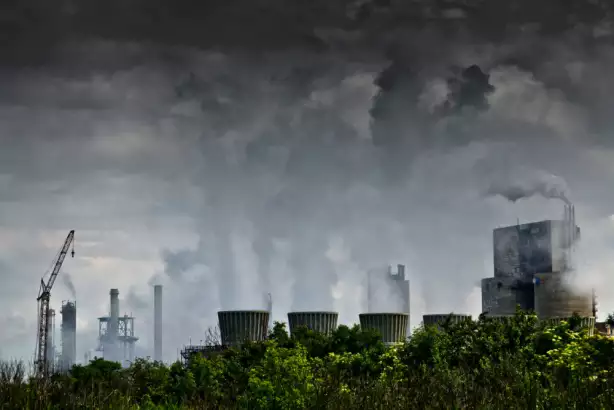RTO and Air Pollution Control
Regenerative Thermal Oxidizers (RTOs) are highly effective air pollution control systems used in various industries. These systems play a crucial role in reducing harmful emissions and ensuring compliance with environmental regulations. In this blog post, we will explore the different aspects and perspectives of RTO and air pollution control.
1. Introduction to Regenerative Thermal Oxidizers (RTOs)
RTOs are advanced air pollution control devices designed to destroy volatile organic compounds (VOCs), hazardous air pollutants (HAPs), and other toxic substances emitted during industrial processes. These systems utilize high temperatures and catalyst beds to oxidize the pollutants, converting them into non-hazardous compounds such as carbon dioxide and water vapor.
Benefits of using RTOs include:
- High Destruction Efficiency: RTOs can achieve destruction efficiencies of over 95%, ensuring effective removal of pollutants.
- Energy Efficiency: The regenerative design of RTOs allows for the recovery of thermal energy, reducing operational costs.
- Environmental Compliance: RTOs help industries meet stringent emission regulations and maintain a clean and sustainable environment.

2. Working Principle of RTOs
RTOs operate based on a cyclic process involving multiple heat exchange chambers. The key steps in the RTO operation are:
- Adsorption: Polluted air enters the oxidizer through an inlet and passes through a ceramic media bed, where VOCs are adsorbed.
- Preheating: The clean air from the outlet of the oxidizer heats the ceramic bed, allowing for the transfer of thermal energy.
- Combustion: The VOCs adsorbed in the ceramic bed are oxidized using a burner, raising the temperature to the desired level for destruction.
- Heat Recovery: The hot, purified air is then directed to the second bed, transferring the accumulated thermal energy for preheating purposes.
- Cooling and Discharge: Finally, the clean air is cooled down before being discharged into the atmosphere, while the process repeats in the other chamber.

3. Applications of RTOs
RTOs find extensive use in various industries, including:
- Chemical Manufacturing: RTOs help control emissions from chemical process units, reducing the impact on air quality.
- Paints and Coatings: The volatile components in paints and coatings are effectively destroyed by RTOs, ensuring compliance with air pollution regulations.
- Pharmaceuticals: RTOs play a crucial role in controlling emissions from pharmaceutical manufacturing processes, safeguarding public health.
- Petrochemicals: RTOs are utilized to eliminate hazardous air pollutants emitted during petrochemical refining operations.
4. Advancements and Future Trends
The field of air pollution control and RTO technology continues to evolve. Some notable advancements include:
- Smart Control Systems: Integration of advanced control algorithms and real-time monitoring allows for optimal RTO performance and energy efficiency.
- Heat Recovery Techniques: Innovative heat exchange methods enhance the thermal efficiency of RTOs, reducing energy consumption.
- Integration with Renewable Energy: The combination of RTOs with renewable energy sources, such as solar power, further reduces the environmental impact.
As industries strive for sustainable practices, the continuous development of RTOs will drive improvements in air pollution control, promoting cleaner and healthier environments worldwide.
会社紹介
We are a high-tech manufacturing enterprise specializing in comprehensive treatment of volatile organic compounds (VOCs) exhaust and carbon reduction energy-saving technology. Our core technologies include thermal energy, combustion, sealing, and self-control. We have capabilities in temperature field simulation, air flow field simulation modeling, ceramic heat storage material performance, molecular sieve adsorbent material selection, and VOCs organic high-temperature incineration and oxidation experimental testing.
チームのメリット
We have established RTO technology research and development center and waste gas carbon reduction engineering technology center in Xi’an, as well as a 30,000 square meters production base in Yangling. We are a leading manufacturer in terms of global sales volume of RTO equipment and zeolite molecular sieve rotary wheel equipment. Our core technical team comes from the Institute of Aerospace Liquid Rocket Engine Research (Aerospace Sixth Institute). Currently, we have more than 360 employees, including over 60 R&D technical backbones, among them are 3 senior engineers at the research fellow level, 6 senior engineers, and 47 doctors of thermodynamics.
コア製品
Our core products include the regenerative thermal oxidizer (RTO) with rotary valve and zeolite molecular sieve adsorption and concentration rotary wheel. With our expertise in environmental protection and thermal energy system engineering, we can provide customers with comprehensive solutions for industrial exhaust gas treatment, energy utilization, and carbon reduction under various operating conditions.
認定、特許、栄誉
- 知的財産管理システム認証
- 品質管理システム認証
- 環境マネジメントシステム認証
- 建設業企業資格
- ハイテク企業
- Patent for Rotary Valve of Rotary Heat Storage Oxidation Furnace
- Patent for Rotary Heat Incineration Equipment with Rotor
- ディスクゼオライトロータリーホイールの特許

適切な RTO 機器の選び方
- 排気ガスの特性を判断する
- 地域の規制と排出基準を理解する
- エネルギー効率を評価する
- 運用とメンテナンスを考慮する
- 予算とコストを分析する
- 適切なRTOタイプを選択する
- 環境と安全の要素を考慮する
- パフォーマンステストと検証を実行する

RTO Air Pollution Control Service Process
- Preliminary consultation, on-site inspection, and needs analysis
- ソリューション設計、シミュレーションモデリング、ソリューションレビュー
- カスタマイズされた生産、品質管理、工場テスト
- オンサイト設置、試運転、トレーニングサービス
- 定期的なメンテナンス、技術サポート、スペアパーツの供給
We are a one-stop solution for RTO air pollution control, providing customized RTO solutions tailored to our customers’ needs. Our professional team is dedicated to delivering high-quality services.
著者宮
